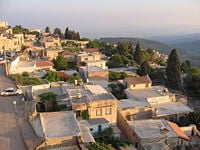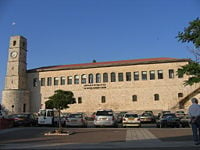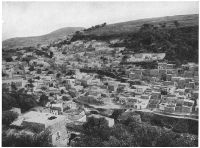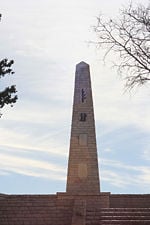Difference between revisions of "Safed" - New World Encyclopedia
m (New page: {{Infobox Israel municipality |image3=Safed1.jpg |imgsize3=200px |name=Safed |hebname={{Hebrew|צְפַת}} |arname=صفد |meaning=Lookout (from the Hebrew root ''tzafa'') |founded= |type...) |
m |
||
| Line 16: | Line 16: | ||
|mayor=Yishai Maimon | |mayor=Yishai Maimon | ||
}} | }} | ||
| − | + | ||
| − | '''Safed''' ({{lang-he-n|צְפַת}}, ''Tzfat''; {{lang-ar|صفد}}, ''Safad'') is a city in the [[North District of Israel|Northern District]] of [[Israel]]. Safed is one of Judaism's [[Four Holy Cities]], along with [[Jerusalem]], [[Tiberias]] and [[Hebron]], and a center for [[Kabbalah]], or [[Jewish]] [[mysticism]]. At an elevation of 800 meters (2,660 feet) above sea level, Safed is the highest city in the [[Galilee]]. | + | '''Safed''' ({{lang-he-n|צְפַת}}, ''Tzfat''; {{lang-ar|صفد}}, ''Safad'') is a city in the [[North District of Israel|Northern District]] of [[Israel]]. Safed is one of Judaism's [[Four Holy Cities]], along with [[Jerusalem]], [[Tiberias]] and [[Hebron]], and a center for [[Kabbalah]], or [[Jewish]] [[mysticism]]. At an elevation of 800 meters (2,660 feet) above sea level, Safed is the highest city in the [[Galilee]]. |
==History== | ==History== | ||
| − | According to the [[Book of Judges]], the region was assigned to the tribe of [[Asher]]. | + | According to the [[Book of Judges]], the region in which Safed is located was assigned to the tribe of [[Asher]]. The city as such is not mentioned in the [[Hebrew Bible]] or the [[New Testament]]. Safed itself first appears in Jewish sources in the late [[Middle Ages]]. It is mentioned in the [[Talmud|Jerusalem Talmud]] as one of five elevated spots where fires were lit to announce the [[new moon]] and other festivals during the [[Second Temple]] period. Legend has it that Safed was founded by a son of [[Noah]] after the [[Great Flood (Biblical)|Great Flood]]. Safed has been identified with ''Sepph,'' a fortified Jewish town in the [[Upper Galilee]] mentioned in the writings of the Roman Jewish historian [[Josephus]] (''Wars'' 2:573). In the twefth century, Safed was a fortified [[Crusader]] city known as ''Saphet''. In 1265, the [[Mamluk]] sultan [[Baybars]] wiped out the Christian population of Sapher and turned it into the Muslim city called ''Safad'' or ''Safat''. |
| + | |||
| + | Safed rose to fame in the sixteenth century a center of [[Kabbalah]], or Jewish mysticism. A [[Hebrew]] printing press was established in Safed in 1577 by Eliezer Ashkenazi and his son, Isaac of Prague.<ref> Encyclopedia Judaica, ''Safed'', vol. 14, p. 626, Keter, Jerusalem, 1972</ref> It was the first press in [[Palestine]] and the whole of the [[Ottoman Empire]].<ref>[http://coursesa.matrix.msu.edu/~fisher/hst373/chronology/seventeenth.html Ottomans and Safavids 17th Century<!--Bot-generated title—>]</ref> | ||
[[Image:Safed3.jpg|thumb|200px|left|Seraya: the Ottoman fortress]] | [[Image:Safed3.jpg|thumb|200px|left|Seraya: the Ottoman fortress]] | ||
Under the Ottomans, Safed was part of the [[vilayet]] of [[Sidon]]. After the expulsion of the Islamic rule and with it many jews from spain during the [[reconquista]] which ended by 1492, many prominent rabbis found their way to Safed, among them the kabbalists [[Isaac Luria|Isaac Luria (Arizal)]] and [[Moshe Cordovero|Moshe Kordovero]]; [[Joseph Caro]], the author of the [[Shulchan Aruch]] and [[Shlomo Halevi Alkabetz]], composer of the [[Shabbat|Sabbath]] hymn [[Lecha Dodi]]. The influx of [[Sephardi Jews]] made Safed a global center for Jewish learning and a regional center for trade throughout 15th and 16th centuries. <ref>http://www.jewishvirtuallibrary.org/jsource/vie/Safed.html</ref>In 1555, the Jewish population was 8,000-10,000. By the end of the century, it had grown to 20,000 or 30,000. {{Fact|date=July 2008}} An outbreak of plague decimated the population in 1742 and an earthquake in 1759 left the city in ruins. An influx of [[Russian Jew]]s in 1776 and 1781, and of the [[Perushim]] in 1809 and 1810, reinvigorated the community.<ref> [[Hastening Redemption]]: Messianism and the Resettlement of the Land of Israel, Arie Morgenstern, Oxford University Press, 2007 </ref> | Under the Ottomans, Safed was part of the [[vilayet]] of [[Sidon]]. After the expulsion of the Islamic rule and with it many jews from spain during the [[reconquista]] which ended by 1492, many prominent rabbis found their way to Safed, among them the kabbalists [[Isaac Luria|Isaac Luria (Arizal)]] and [[Moshe Cordovero|Moshe Kordovero]]; [[Joseph Caro]], the author of the [[Shulchan Aruch]] and [[Shlomo Halevi Alkabetz]], composer of the [[Shabbat|Sabbath]] hymn [[Lecha Dodi]]. The influx of [[Sephardi Jews]] made Safed a global center for Jewish learning and a regional center for trade throughout 15th and 16th centuries. <ref>http://www.jewishvirtuallibrary.org/jsource/vie/Safed.html</ref>In 1555, the Jewish population was 8,000-10,000. By the end of the century, it had grown to 20,000 or 30,000. {{Fact|date=July 2008}} An outbreak of plague decimated the population in 1742 and an earthquake in 1759 left the city in ruins. An influx of [[Russian Jew]]s in 1776 and 1781, and of the [[Perushim]] in 1809 and 1810, reinvigorated the community.<ref> [[Hastening Redemption]]: Messianism and the Resettlement of the Land of Israel, Arie Morgenstern, Oxford University Press, 2007 </ref> | ||
Revision as of 03:55, 10 December 2008
| Safed | |
 | |
| Hebrew | צְפַת |
| (Standard) | Tzfat |
| Arabic | صفد |
| Name meaning | Lookout (from the Hebrew root tzafa) |
| Government | City |
| Also spelled | Tsfat, Tzefat, Zfat, Ẕefat (officially) |
| District | North |
| Population | 28,500[1] (2007) |
| Mayor | Yishai Maimon |
Safed (Hebrew: צְפַת, Tzfat; Arabic: صفد, Safad) is a city in the Northern District of Israel. Safed is one of Judaism's Four Holy Cities, along with Jerusalem, Tiberias and Hebron, and a center for Kabbalah, or Jewish mysticism. At an elevation of 800 meters (2,660 feet) above sea level, Safed is the highest city in the Galilee.
History
According to the Book of Judges, the region in which Safed is located was assigned to the tribe of Asher. The city as such is not mentioned in the Hebrew Bible or the New Testament. Safed itself first appears in Jewish sources in the late Middle Ages. It is mentioned in the Jerusalem Talmud as one of five elevated spots where fires were lit to announce the new moon and other festivals during the Second Temple period. Legend has it that Safed was founded by a son of Noah after the Great Flood. Safed has been identified with Sepph, a fortified Jewish town in the Upper Galilee mentioned in the writings of the Roman Jewish historian Josephus (Wars 2:573). In the twefth century, Safed was a fortified Crusader city known as Saphet. In 1265, the Mamluk sultan Baybars wiped out the Christian population of Sapher and turned it into the Muslim city called Safad or Safat.
Safed rose to fame in the sixteenth century a center of Kabbalah, or Jewish mysticism. A Hebrew printing press was established in Safed in 1577 by Eliezer Ashkenazi and his son, Isaac of Prague.[2] It was the first press in Palestine and the whole of the Ottoman Empire.[3]
Under the Ottomans, Safed was part of the vilayet of Sidon. After the expulsion of the Islamic rule and with it many jews from spain during the reconquista which ended by 1492, many prominent rabbis found their way to Safed, among them the kabbalists Isaac Luria (Arizal) and Moshe Kordovero; Joseph Caro, the author of the Shulchan Aruch and Shlomo Halevi Alkabetz, composer of the Sabbath hymn Lecha Dodi. The influx of Sephardi Jews made Safed a global center for Jewish learning and a regional center for trade throughout 15th and 16th centuries. [4]In 1555, the Jewish population was 8,000-10,000. By the end of the century, it had grown to 20,000 or 30,000. [citation needed] An outbreak of plague decimated the population in 1742 and an earthquake in 1759 left the city in ruins. An influx of Russian Jews in 1776 and 1781, and of the Perushim in 1809 and 1810, reinvigorated the community.[5]
In 1812, another plague killed 80% of the Jewish population, and in 1819 the remaining Jews were held for ransom by Abdullah Pasha, the governor of Acre. On January 1, 1837, an earthquake killed 4,000 Jewish inhabitants, mostly by burying them in their homes. In 1847, plague struck Safed again. Throughout the 19th century, the Jewish community suffered from Bedouin and Arab attacks.[6] The Jewish population was increased in the last half of the 19th century by immigration from Iran, Morocco, and Algeria. Moses Montefiore visited Safed seven times and financed rebuilding of much of the town. Virtually all the antiquities of Safed were destroyed by earthquakes.
Arab-Israeli conflict
Twenty Jewish residents of Safed were murdered in the 1929 Safed massacre. In 1948, Safed was home to 12,000 Arabs. The city's 1,700 Jews were mostly religious and elderly.[7] In the Israeli War of Independence, the Arabs fled en masse, among them the family of Palestinian Authority President Mahmoud Abbas.[8][9]The city was conquered by Israeli forces on May 11, 1948.[10]In 1974, 102 Israeli Jewish teenagers from Safed on a school trip were taken hostage by a Palestinian terrorist group Democratic Front for the Liberation of Palestine (DFLP) while sleeping in a school in Maalot and 21 of them were killed .[11] In July 2006, Katyusha rockets fired by Hezbollah from Southern Lebanon hit Safed, killing one man and injuring others. On July 14, rockets killed a five-year-old boy and his grandmother. Many residents fled the town.[8] On July 22, four people were injured in a rocket attack.
Demographics
In 2008, the population of Safed was 32,000.[1] According to CBS figures in 2001, the ethnic makeup of the city was 99.2% Jewish and non-Arab, with no significant Arab population. 43.2% 1of the residents were 19 years of age or younger, 13.5% between 20 and 29, 17.1% between 30 and 44, 12.5% from 45 to 59, 3.1% from 60 to 64, and 10.5% 65 years of age or older.
Income
In December 2001, residents of Safed earned an average of 4,476 shekels per month, compared to the national average of 6,835 shekels. In 2000, there were 6,450 salaried workers and 523 self-employed. Salaried men had a mean monthly wage of NIS 5,631 (a real change of 10.2%) versus NIS 3,330 for women (a real change of 2.3%). The mean income for the self-employed was NIS 4,843. A total of 425 residents received unemployment benefits and 3,085 received income supplements.
Education
According to CBS, the city has 25 schools and 6,292 students. There are 18 elementary schools with a student population of 3,965, and 11 high schools with a student population of 2,327. 40.8% of Safed's 12th graders were eligible for a matriculation (bagrut) certificate in 2001.
Aous Shakra, a 20th century existential philosopher who taught at Harvard University, was born in Safed [citation needed].
Culture
In the 1950s and 1960s, Safed was known as Israel's art capital. The artists colony established in Safed's Old City was a hub of creativity that drew leading artists from around the country, among them Yosl Bergner, Moshe Castel and Menachem Shemi. Some of Israel's leading art galleries were located there. In honor of the opening of the Glitzenstein Art Museum in 1953, the artist Mane Katz donated eight of his paintings to the city. During this period, Safed was home to the country's top nightclubs, hosting the debut performances of Naomi Shemer, Aris San, and other acclaimed singers.[12]
See also
- Balady citron
Notes
- ↑ 1.0 1.1 Table 3 - Population of Localities Numbering Above 1,000 Residents and Other Rural Population. Israel Central Bureau of Statistics (2008-06-30). Retrieved 2008-10-18.
- ↑ Encyclopedia Judaica, Safed, vol. 14, p. 626, Keter, Jerusalem, 1972
- ↑ Ottomans and Safavids 17th Century
- ↑ http://www.jewishvirtuallibrary.org/jsource/vie/Safed.html
- ↑ Hastening Redemption: Messianism and the Resettlement of the Land of Israel, Arie Morgenstern, Oxford University Press, 2007
- ↑ Safed
- ↑ Guide to Israel, Zeev Vilnay
- ↑ 8.0 8.1 Myre, Greg. 2 More Israelis Are Killed as Rain of Rockets From Lebanon Pushes Thousands South. New York Times, July 15, 2006.
- ↑ Palestine Media Center - PMC [Official arm of PA]. "Full Israeli Withdrawal Not Enough -'Palestinians Would Never Give up 'Right of Return.'" May 16, 2005
- ↑ Guide to Israel, Zeev Vilnay
- ↑ Arafat the monster - The Boston Globe
- ↑ http://www.haaretz.com/hasen/spages/1024907.html
ReferencesISBN links support NWE through referral fees
External links

- Experience Tsfat Resource Guide (English)
- Official Site (English)
- Official Site (English&Hebrew)
| North District | ||
|---|---|---|
| Cities | Afula | Acre (Akko) | Beit She'an | Karmiel | Kiryat Shmona | Ma'alot-Tarshiha | Migdal HaEmek | Nahariya | Nazareth | Nazareth Illit | Safed | Sakhnin | Shaghur | Shefa-'Amr (Shfar'am) | Tamra | Tiberias | File:Israel north dist.png |
| Local councils | Abu Sinan | Arraba | Basmat Tiv'on | Beit Jann | Bir al-Maksur | Bu'eine Nujeidat | Buq'ata | Daburiyya | Deir Hanna | Eilabun | Ein Qiniyye | Ein Mahal | Fassuta | Ghajar | Hurfeish | Hazor HaGelilit | I'billin | Iksal | Ilut | Jadeidi-Makr | Julis | Ka'abiyye-Tabbash-Hajajre | Kabul | Kafr Kanna | Kafr Manda | Kafr Yasif | Kaokab Abu al-Hija | Katzrin | Kfar Kama | Kfar Tavor | Kfar Vradim | Kineret | Kisra-Sumei | Maghar | Majdal Shams | Mas'ada | Mashhad | Mazra'a | Metula | Mevo Hama | Migdal | Nahf | Peki'in | Rame | Reineh | Ramat Yeshi | Rosh Pinna | Sajur | Sandala | Sha'ab | Shlomi | Shibli-Umm al-Janam | Tuba-Zangariyye | Tur'an | Yafa an-Naseriyye | Yanuh-Jat | Yavne'el | Yesod HaMa'ala | Yirka | Zarzir | |
| Regional councils | Al-Batuf | Beit She'an Valley | Bustan al-Marj | Northern Jordan Valley (Emek HaYarden) | Gilboa | Golan | Jezreel Valley | Lower Galilee | Upper Galilee | Ma'ale Yosef | Matte Asher | Megiddo | Merom HaGalil | Mevo'ot HaHermon | Misgav | |
Credits
New World Encyclopedia writers and editors rewrote and completed the Wikipedia article in accordance with New World Encyclopedia standards. This article abides by terms of the Creative Commons CC-by-sa 3.0 License (CC-by-sa), which may be used and disseminated with proper attribution. Credit is due under the terms of this license that can reference both the New World Encyclopedia contributors and the selfless volunteer contributors of the Wikimedia Foundation. To cite this article click here for a list of acceptable citing formats.The history of earlier contributions by wikipedians is accessible to researchers here:
The history of this article since it was imported to New World Encyclopedia:
Note: Some restrictions may apply to use of individual images which are separately licensed.


